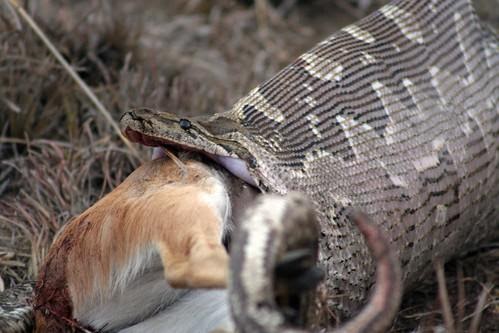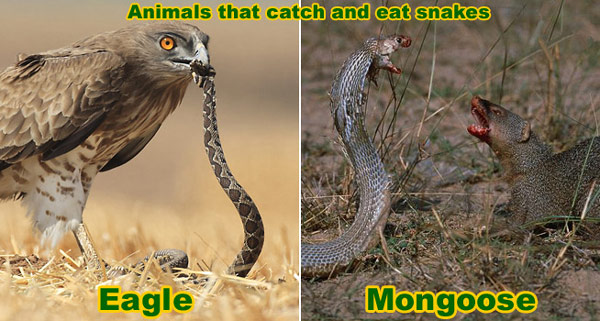What Eats a Snake: Predators Unveiled

Several animals are known to eat snakes, including mongooses, wild boars, wolverines, alligators, eagles, hawks, and various snake species. Snakes have numerous predators in their natural environment.
Badgers, weasels, wild cats, domestic cats, and raptors such as eagles and hawks are major snake predators. Additionally, cranes and secretary birds are also known to prey on snakes, while the mongoose, honey badgers, and king snakes are capable of hunting and killing snakes.
With a variety of predators, snakes face numerous threats in their ecosystems.
The Snake’s Natural Enemies
Snakes are fascinating creatures that have evolved to adapt to various environments and habitats. They are an essential part of the food chain, playing a crucial role in maintaining the ecological balance. However, like all animals, snakes too have natural enemies that prey on them. In this article, we will discuss some of the snake’s natural enemies in the wild.
Mammalian Predators
Several mammalian predators are known to hunt and eat snakes. Badgers and weasels are major snake predators, while various species of wild cats such as mountain lions, bobcats, ocelots, and jaguarundis are also known to take down snakes. Domestic and feral cats also fall under this category of predators. Raccoons, skunks, and foxes are some other mammals that feed on snakes.
Avian Adversaries
Many birds of prey, such as eagles, falcons, and hawks, hunt snakes for their meals. Cranes and secretary birds also occasionally eat snakes using their long legs and beaks. Herons are another type of bird that preys on snakes. Owls are known to catch and eat smaller species of snakes. In some cases, even the smaller birds like the roadrunner and the kingfisher can also hunt and eat snakes.
In addition to these, there are some other animals like honey badgers and mongooses that are known to hunt and kill snakes. Some snake species, like the king snake, are known to eat other snakes as their primary diet.
It’s important to note that while these animals may be predators of snakes, they are also crucial to maintaining the ecological balance in their respective environments. Without these predators, the population of snakes and other prey species may grow out of control, leading to an imbalance in the food chain.

Credit: biomedicalsciences.unimelb.edu.au
Birds Of Prey: The Winged Hunters
Eagles And Hawks
Eagles and hawks are skilled hunters that prey on snakes.
Owls: Nocturnal Nemesis
Owls, the silent nocturnal hunters, are also known to hunt snakes under the cover of darkness.
The Feline Factor
When it comes to the natural world, snakes are both predators and prey. They rely on their speed, stealth, and venom to catch their meals, but they also have their own set of predators to watch out for. In this blog post, we will explore the fascinating world of snake predators, with a focus on the feline factor.
Big Cats And Their Prey
Big cats such as lions, tigers, and leopards are formidable predators in the wild. Snakes, with their slithering movements and camouflaged bodies, often become unsuspecting prey for these powerful felines. With their sharp claws and powerful jaws, big cats are well-equipped to catch and consume snakes as part of their diet. These majestic creatures play a significant role in controlling snake populations in their natural habitats.
Domestic Cats: Unexpected Hunters
While big cats are known for hunting snakes in the wild, domestic cats also exhibit surprising hunting behaviors. Despite being domesticated, cats still retain their natural instincts as skilled hunters. They may not be tackling venomous snakes like their larger counterparts, but they are known to catch and play with smaller snake species. This unexpected hunting behavior showcases the innate predatory nature of all feline species, whether big or small.

Credit: earthlife.net
Reptiles Against Their Own
Snakes have several natural enemies in the animal kingdom. Predators such as eagles, hawks, honey badgers, and mongoose are known to hunt and kill snakes. Additionally, king snakes are notorious for preying on other snakes, making them a formidable threat in the wild.
King Snakes: Cannibalistic Cousins
King snakes are notorious for their cannibalistic behavior, preying on their own kind. They are immune to the venom of other snakes, making them formidable predators within the reptile kingdom. Their adaptability and resistance to snake venom make them a formidable threat to other snake species.
Crocodilians: Semi-aquatic Snatchers
Crocodilians, such as alligators and crocodiles, are semi-aquatic reptiles known for their ability to prey on snakes. With their powerful jaws and stealthy hunting techniques, they are capable of ambushing and consuming snakes. Their aquatic habitats provide them with the ideal environment to hunt and capture unsuspecting snakes.
Snakes face threats not only from other predators, but also from their own kind. While king snakes exhibit cannibalistic tendencies, crocodilians utilize their semi-aquatic habitats to snatch and consume snakes. Understanding the dynamics of reptilian predation sheds light on the complex interactions within the reptile ecosystem.
The Mighty Mongoose
The Mighty Mongoose is a formidable predator that preys on snakes, including the most venomous ones. With lightning-fast reflexes, the mongoose can outmaneuver and swiftly attack its serpentine prey, making it one of the top predators in the snake’s food chain.
Mongoose Vs. Snake: A Classic Duel
The mongoose is a fierce predator known for its agility and lightning-fast reflexes. When pitted against a snake, the mongoose showcases its remarkable skills in a classic battle for survival.Techniques Of A Mongoose Attack
The mongoose uses a combination of techniques to take down its serpentine foe. With its quick movements and razor-sharp teeth, it can swiftly evade the snake’s strikes and launch a counterattack, often targeting the snake’s head or neck. In the wild, the mongoose’s ability to outmaneuver and overpower snakes has solidified its reputation as one of the most formidable adversaries of these slithering reptiles. The mongoose’s agility and cunning make it a formidable opponent for any snake, and its predatory prowess has been observed in various ecosystems around the world.Amphibian And Insectivorous Predators
Snakes, despite being formidable predators themselves, are not immune from predation. In the natural world, several creatures feed on snakes, and among them are amphibians and insectivorous animals. Let’s delve into the specific predators in these two categories.
Frogs And Toads As Predators
Frogs and toads are known to prey on snakes, especially the smaller species. Their ability to ambush and capture snakes is facilitated by their agility and swift tongue strikes. Additionally, the toxic secretions some frog and toad species possess act as a defense mechanism against snakes, allowing them to overpower and consume their serpentine prey.
Insects And Arachnids Preying On Snakes
Insects and arachnids also play a role in the predation of snakes. Certain species of ants, beetles, and spiders have been observed attacking and consuming snakes, particularly when the snakes are in a vulnerable state, such as during molting or when they are injured. These tiny predators can overwhelm snakes through sheer numbers and by exploiting any weaknesses in their defenses.
The Role Of Raptors
Secretary Birds: Stomp To Kill
Secretary birds use their long legs to stomp on snakes, effectively killing or stunning them.
Falcon’s Deadly Strike
Falcons have a deadly strike when hunting snakes, swiftly capturing their prey with precision.
Human Impact On Snake Predation
Various animals play a role in snake predation, including badgers, weasels, wild cats like mountain lions and bobcats, and domestic cats. Birds of prey such as eagles, hawks, and cranes are also known to prey on snakes, along with mammals like honey badgers and mongooses.
Hunting And Habitat Loss
Human impact on snake predation has resulted in a significant decrease in the population of snakes. Hunting and habitat loss are two of the most common reasons why snakes are losing their natural habitats. People have been hunting snakes for their skin, meat, and other body parts for many years. Snake hunting has become a major industry in many parts of the world, which is contributing to the decline in their numbers. Habitat loss is another major cause of snake population decline. As human populations increase, natural habitats are being destroyed to make way for cities and towns. This leaves snakes with nowhere to go, and they are forced to seek new habitats that may not be suitable for their survival. The loss of habitat also means that snakes have fewer prey species to feed on, which further impacts their survival.Fear And Misunderstanding
Fear and misunderstanding are also contributing factors to the decline in snake populations. Many people fear snakes and view them as dangerous and deadly creatures. This fear has led to the killing of snakes on sight, even if they are not posing any threat to humans. In addition, there is a lack of understanding about the important role snakes play in the ecosystem. Snakes help to control the populations of rodents and other small animals, which can cause damage to crops and spread diseases. In conclusion, human impact on snake predation is a serious issue that needs to be addressed. Hunting and habitat loss, as well as fear and misunderstanding, are causing a decline in snake populations worldwide. It is important for people to understand the vital role that snakes play in the ecosystem and to take steps to protect them from harm. By working together, we can ensure that snakes and other wildlife are able to thrive and survive for generations to come.Defense Mechanisms Of Snakes
Snakes have evolved various defense mechanisms to protect themselves from predators and threats in their environment. These mechanisms enable snakes to survive and thrive in diverse habitats.
Venom As A Counterattack
Venom is one of the most potent weapons in a snake’s defense arsenal. When threatened, snakes can deliver a venomous bite to deter predators or attackers.
Camouflage And Escape Tactics
Snakes also employ camouflage to blend into their surroundings, making it harder for predators to spot them. Additionally, snakes are adept at using escape tactics such as rapid slithering or hiding in burrows to evade danger.

Credit: www.wildlife-removal.com
Conservation Efforts For Snakes
Protecting Predators And Prey
Preserving the balance in ecosystems by safeguarding both snake predators and prey.
Education And Awareness Programs
Raising public understanding through educational initiatives to promote snake conservation.
Frequently Asked Questions
What Are The Predators Of Snakes?
In nature, snakes have several predators. Badgers, weasels, and wild cats like mountain lions, bobcats, ocelots, and jaguarundis are some of the major snake predators. Raptors such as eagles, hawks, and falcons also prey on snakes. Honey badgers, mongooses, and king snakes are also known to hunt and kill snakes.
Snakes’ greatest enemy is the mongoose, which can attack and bite the back of the cobra’s neck before it can defend itself.
What Animal Eats A Snake In A Food Chain?
Eagles, hawks, cranes, and mongooses are animals that eat snakes in a food chain.
What Animal Kills Snakes?
Mongoose, honey badgers, eagles, hawks, and king snakes are animals that hunt and kill snakes.
What Is The Snake’s Greatest Enemy?
The snake’s greatest enemy is the mongoose, known for its speed and ability to strike the snake’s neck before it can defend itself. Other predators include birds of prey like eagles and hawks, as well as honey badgers and king snakes.
Conclusion
To sum up, snakes have several predators in the animal kingdom. From birds like eagles and hawks to mammals such as mongoose and honey badgers, various species hunt and kill snakes. Understanding the predators of snakes is crucial for their survival in the wild.



